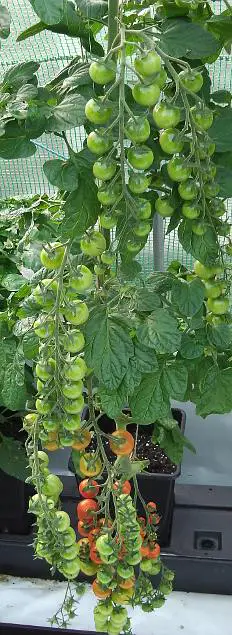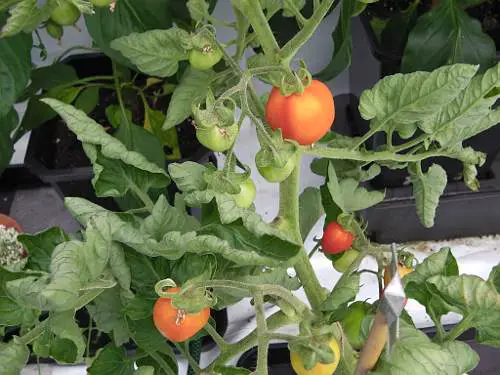I arrived home from my holiday to find that the watering system did work – phew…that’s a relief! Some plants were over or under watered but all were alive and pleased to see me!

It’s amazing how much growth can be made in just one week but we don’t notice it so much when we see our plants everyday.
As you probably know, I’m using different growing systems including the auto pot easy2grow and the quadgrow planter to name but two. The plants in these systems were watered very well while I was away.
The plants are showing…
- No sign of stress in their leaves – curled leaves are often a sign of plant stress.
- No split skins in the Sungold variety – this variety often splits its skins.
- Only one tomato with blossom end rot (out of about 400).
- Good long trusses of consistent size fruit.

The photo on the right is a Piccolo variety in a Quadgrow planter. Notice that the leaves are stress-free and healthy looking. I’ll remove that lowest leaf branch.
When a plant has access to water and nutrients 24/7, it feels happy.
This season I shall remove more leaf branches owing to the good weather and vigorous growth of the plants. On a plant with around seven trusses, I’ll gradually remove leaves up to the fifth truss.
I need to remove the very small tomatoes at the end of the bottom left truss to encourage growth in the rest of the truss.
Sometimes trusses grow another leaf and side shoot at their tip. Also leaves can sprout a side shoot from the middle of their stem!
These are signs of increased vigour owing to the bright warm weather and could also be the result of too much nitrogen or a high nutrient strength generally.
In contrast, here’s a photo (below) of a Roma variety growing in a large pot. It has suffered from stress caused by under/over watering in hot weather. The leaves don’t know which way to turn and the fruit are also of variable size.
When more moderate temperatures return, and water is available on a more consistent basis, the tomatoes will grow to a more consistent size too.

Nutrient Strength – Measured in EC – Electrical Conductivity
I’ve been shopping for brands of tomato food this week and have managed to buy around six different brands so far.
Here are the results of my EC tests – if your brand isn’t in the list below, Doff and Maxicrop for example, it should be around the same EC as Tomorite and Grow Sure. I’ll try to get hold of these for next week’s newsletter.
The tests were carried out with the recommended dose of each brand. For example, 20 ml in 4.5 litres of water, then the water was tested to find the nutrient strength.
The background EC strength of my tap water is 0.16
- Tomorite EC 1.9 – also contains seaweed extract.
- Gro Sure (Westland) EC 2.0 – contains seaweed, magnesium and iron.
- Verve (B&Q) EC 1.9 – with seaweed extract, magnesium and wetting agent.
- Grow Your Own (Homebase) EC 1.2 – a basic feed that is weaker than most other synthetic nutrients.
When growing in soil it is usual practice to feed nutrients at 50% of the strength that would normally be given to hydroponically grown tomatoes.
This means that if hydroponic tomatoes are given an EC of 2.0, then an EC of 1.0 is perfectly good for plants grown in soil – in containers, pots and grow bags.
The EC of the synthetic brands: Tomorite, Gro Sure and Verve are about the same at 1.9 to 2.0.
This means that it is good to feed your plants half strength at every watering, that is an EC of around 1.0.
When growing hybrids and large varieties, I would increase the EC to around 1.5 for growing in soil. This would be around 75% strength at every watering.
[Alternating between half and three quarter strength would probably be better.]Measuring amounts for feeding at every watering.
If for example, 40ml is the standard recommended measure for 10 litres of water.
Half strength (50%) is 20ml in 10 litres of water.
75% strength is 30ml in 10 litres of water.
- Miracle Grow Fruit & Veg (organic) EC 3.0 – (that’s higher than most other feeds) this feed looks great, dark and full of nourishment, but the term organic may be slightly misleading. It is a feed that is created by organic methods but still contains chemicals.
I would give this at 33% strength to my tomatoes growing in soil – pots and grow bags.
A true organic feed would register very little on the EC scale. For example, Bio Bizz Bloom is 0.6 and Doff Seaweed Extract is 0.2 … my tap water is 0.16!
A quick word about organics.
Plants don’t absorb true organic feed immediately – it has to be processed by soil microbes into a state that roots can absorb.
This means that if you are feeding plants organic food, Including seaweed extract as added to the synthetic brands like Tomorite, you need to encourage friendly bacteria and fungi to develop in your soil.
Tap Water
Tap water contains chlorine (and other stuff) which kills friendly soil bacteria, but if you fill your watering can and leave it overnight, much of the chlorine vanishes and isn’t so harmful to your soil microbes – friendly bacteria and fungi.
The seaweed, which contains plenty of potassium and important micro nutrients, is then able to be processed by soil microbes, and absorbed by the plant’s roots.
General Feeding Points to Consider
- Over feeding usually produces a lower yield and smaller fruit.
- However, a higher strength feed is considered to increase the taste and nutritional value of tomatoes.
- It’s best not to increase the nitrogen levels as we come towards the end of the season because it can reduce the taste and slow ripening.
- Hybrid F1’s usually prefer a slightly higher strength because of their vigour.
- Large varieties often prefer a slightly higher strength because they have more growing to do and have greater nutrient requirements.
- Standard, open pollinated varieties are often content with a slightly lower nutrient strength – their growth rate is often slower.
- It is important to have plants in a grow bag that prefer the same nutrient strength. This could be three hybrids, three open pollinated standards or perhaps three large beefsteak varieties.
Adjustments for weather
If the weather is very hot, it’s important to reduce the EC because the higher the nutrient strength, the slower that a plant can absorb water through its roots owing to osmosis.
In other words, pure water is more quickly absorbed by roots than water with nutrients in it. So, if healthy plants wilt in hot weather, it may be that they are unable to absorb water fast enough owing to over feeding.
In cloudy weather when light levels are low, and so is transpiration, nutrient strength can be increased because plants are absorbing less water.
Divergence of Opinion
There is no one ideal method or one ideal strength when it comes to feeding tomatoes. Many tomato growers have their own methods and preferred nutrient strengths and have their own formula for the various stages of a plant’s growth.
In the end it comes down to experience and finding out what works best in your garden and greenhouse.
I hope I have given you food for thought!
Regards,
Nick
